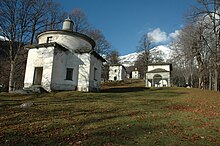Oropa
Oropa is a district of the Italian city of Biella .
geography
The place is located about twelve kilometers northwest of the city of Biella in a valley through which the Torrente Oropa flows. A winding road leads from Biella via Favaro to the village located at approx. 1150 m slm . In 2005 the Piedmont region set up the Riserva Speciale del Sacro Monte di Oropa (special nature reserve of the Sacro Monte of Oropa), which covers the entire basin of Oropa up to the border with the Aosta Valley .
Place of pilgrimage
Oropa is known as a Catholic place of pilgrimage , which was probably built on the site of a pre-Christian place of worship. Today's pilgrimage site consists of the old pilgrimage church in which the Gothic statue of the Black Madonna from the first half of the 14th century is venerated, the Holy Mountain , which was built in the 17th century and, since 2003, together with eight other Sacri Monti in Piedmont and Lombardy, a UNESCO World Heritage Site , and the new basilica, which was inaugurated in 1960.
Infrastructure
In Oropa there are various options for food and accommodation for the pilgrims. There has been a botanical garden since 1998 and an adventure park since 2012 .
In 1926, the first aerial cableway from Oropa to the hill between Monte Camino ( 2388 m slm ) and Monte Mucrone (2335 m) was built. In 1962 the cable car was rebuilt parallel to the old route and completely overhauled in 2001. At the mountain station at an altitude of approx. 1810 m there are two mountain houses, the Rifugio Savoia and the Rifugio Rosazza . A hiking trail leads from the station to the south-western Lago del Mucrone (1894 m).
There has been a meteorological and seismographic observatory in Oropa since 1874 . It was founded by Francesco Denza (1834-1894), a priest of the Barnabites from Naples .
On July 4, 1911, just two years after the start of construction, the electric narrow-gauge railway (Verrovia Biella-Oropa) was opened. It had a length of approx. 14 km and overcame an altitude difference of approx. 800 m. The railway completed its last trip on March 29, 1958 and was then replaced by a bus line.
Sports
Oropa was a stage of the Giro d'Italia six times :
| year | stage | date | Stage start and finish | km | Stage winner | Overall winner |
|---|---|---|---|---|---|---|
| 1963 | 11ª | May 29th | Asti > Oropa | 130 |
|
|
| 1993 | 20ª | June 11th | Turin > Oropa | 162 |
|
|
| 1999 | 15ª | 30th May | Racconigi > Oropa | 160 |
|
|
| 2007 | 13ª | 25. May |
Biella > Oropa (individual time trial) |
12.6 |
|
|
| 2014 | 14ª | May 24th | Agliè > Oropa | 184 |
|
|
| 2017 | 14ª | May 20th | Castellania > Oropa | 131 |
|
|
Web links
- Site of the pilgrimage site of Oropa (Italian / English / Dutch)
- Side of the cable car (Italian)
Individual evidence
- ↑ Riserva sacro monte on santuariodioropa.it (Italian) accessed on May 19, 2018
- ↑ Giardino botanico on santuariodioropa.it (Italian) accessed on May 19, 2018
- ↑ Le Funivie di Oropa e il Parco Avventura on santuariodioropa.it (Italian) accessed on May 19, 2018
- ↑ Storia on funivieoropa.it (Italian) accessed on May 19, 2018
- ↑ Osservatorio di Oropa on osservatoriodioropa.it (Italian) accessed on May 19, 2018
- ↑ La storia on ferroviabiellaoropa.it (Italian) accessed on May 19, 2018
Coordinates: 45 ° 37 ′ 33 " N , 7 ° 58 ′ 57.8" E


